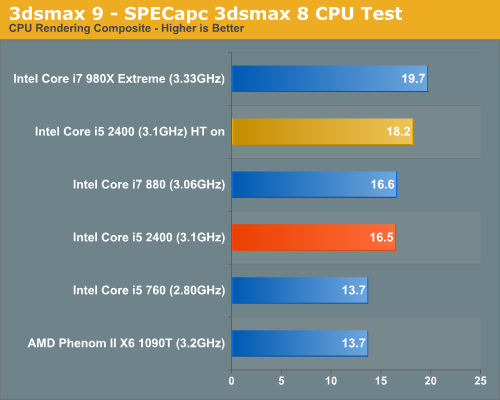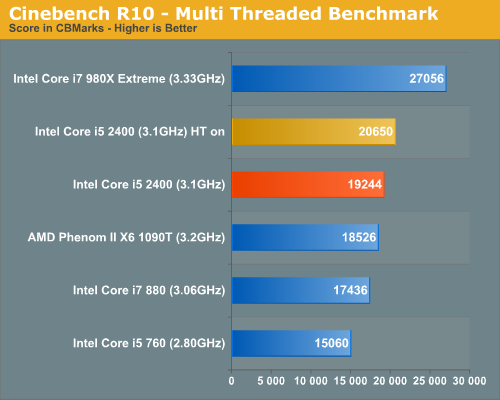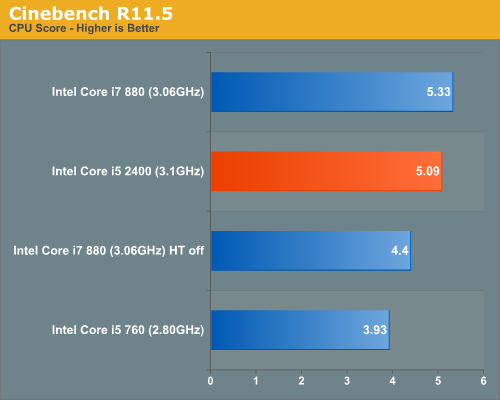The Sandy Bridge Preview
by Anand Lal Shimpi on August 27, 2010 2:38 PM EST3dsmax 9 - SPECapc 3dsmax CPU Rendering Test
Today's desktop processors are more than fast enough to do professional level 3D rendering at home. To look at performance under 3dsmax we ran the SPECapc 3dsmax 8 benchmark (only the CPU rendering tests) under 3dsmax 9 SP1. The results reported are the rendering composite scores:

This is another one of those situations where the Core i5 2400 without Hyper Threading is able to perform on par with the Core i7 880 with Hyper Threading. Compared to the i5 760 it’s 20.5% faster.
With Hyper Threading enabled, the Core i5 2400 is actually dangerously close to the 6-core 980X. Whatever Intel has done to Sandy Bridge's FP is big.
Cinebench R10
Created by the Cinema 4D folks we have Cinebench, a popular 3D rendering benchmark that gives us both single and multi-threaded 3D rendering results.

Cinebench was particularly surprising because it gives us a good opportunity to look at single threaded FP performance. Compared to a similarly clocked Lynnfield, Sandy Bridge can deliver 11% better performance. Compared to a similarly positioned Lynnfield, Sandy Bridge is about 20% faster. Note that this is without turbo enabled. The retail 3.1GHz chip should turbo up to 3.4GHz in this test, giving it a 9.6% frequency boost.
In the multithreaded test Sandy Bridge’s per-core performance is even better than Lynnfield with HT enabled.

I also ran a few numbers using Cinebench R11.5. I didn’t have the opportunity to test the i5 2400 with HT enabled in this test so I measured performance of the i7 880 with HT enabled/disabled to compare per-thread performance.

Sandy Bridge's FP performance is very good. Clock for clock we see a 15.6% improvement over Lynnfield (4C/4T vs. 4C/4T). Compared to the proposed similarly priced Core i5 760, the i5 2400 would be 29.5% faster.
POV-Ray 3.73 beta 23 Ray Tracing Performance
POV-Ray is a popular, open-source raytracing application that also doubles as a great tool to measure CPU floating point performance.
I ran the SMP benchmark in beta 23 of POV-Ray 3.73. The numbers reported are the final score in pixels per second.

The similarly positioned/priced Core i5 760 is beat by 17%. There’s no replacement for more cores/threads however as the i7 880 and X6 parts both pull ahead. Turn on HT to level the playfield (at least within Intel) and Sandy Bridge is 15% faster than Lynnfield.










200 Comments
View All Comments
tatertot - Tuesday, August 31, 2010 - link
Can you also confirm whether or not the GPU turbo was also disabled?DanNeely - Saturday, August 28, 2010 - link
Do you think Intel will be sharing preliminary performance/pricing data on LGA 2011 by the time that the first LGA 1155 parts start shipping? I'm on 1366 now and would like to know if staying on the high end platform will be a reasonable option or if there isn't any point in holding off for another 6 months on my upgrade.Anand Lal Shimpi - Saturday, August 28, 2010 - link
I wouldn't expect any near-final LGA-2011 performance data until Q2 next year, well after the LGA-1155 launch.Take care,
Anand
Casper42 - Saturday, August 28, 2010 - link
2 things jumped out at me1) No USB3 - Major FAIL. Putting USB3 in an Intel chipset will drive huge adoption rates rather than this limping in BS by manufacturers today. Not to mention that for Hard Drives, USB2 has been a bottleneck for a long time whereas only top end SSDs today are maxing out SATA3
2) 2 chips with Quad Core and no HT that are identical except for Clock speed and one of them is essentially the 400 and the other is the 500? WTF? Call them the 2410, 2420, 2430, etc. That gives you like 8 or 9 speed bins for that family. Whomever is doing the numbering at Intel needs a swift kick to the head to get them back on track mentally as things just get more and more confusing. You have the i3/i5/i7 today, why not just change it to:
i2 = Dual Core no HT/Turbo
i3 = Dual Core with HT and/or Turbo
i4 = Quad Core no HT/Turbo
i5 = Quad WITH
i6 = Six without
etc
As it stands now we have i5 with both dual and quad core and i7 with 4 and 6. just doesnt make sense.
dertechie - Saturday, August 28, 2010 - link
That's quite the IPC improvement there. Not quite Netburst to Core 2 but a lot more than I expected (I was expecting something on the order of 5%, with most gains coming from ramping clocks with the extra headroom of 32nm).Question is, do I want the i5-2500K more than I loathe Intel's motherboard department? I'm seeing them bring out new sockets almost as often as new processor families, which really, really does not make me confident in the socket's future.
I will wait at least for Bulldozer benches before buying whatever makes sense at that time (okay, probably weighted in AMD's favor). I've lasted 4 years on this Pentium D, I can live another half of one.
IntelUser2000 - Saturday, August 28, 2010 - link
Why do some people still compare Netburst vs. Core 2? The Pentium 4 generation was a clock speed focused that that FAILED to realize its clock speed potential so it looked really bad compared to Core 2.Compared to Core Duo Core 2 was only 15-20% faster. Sandy Bridge manages to do another 20%, which is really good in a generation, yea?
ssj4Gogeta - Saturday, August 28, 2010 - link
Pentium D to SB will be such a huuuuge jump, lol.neslog - Saturday, August 28, 2010 - link
Your excellent article was exciting to read. Thank you!I noticed a small typo on the Windows 7 Gaming Performance page in the first line under the Data Recovery chart : "Clock for clock...to the i7{5} 760..."
ET - Saturday, August 28, 2010 - link
I think that the integrated graphics here are a game changer. Sure nobody will look to them for serious gaming, but finally they're at a point where if you buy any CPU you will be able to play most games, even if at low settings. I'll be looking forward especially to the mobile CPU's. With Bobcat around the corner, I guess next year we will finally see mainstreams notebooks become capable of some game playing, which will be great (and bad for NVIDIA).Exodite - Saturday, August 28, 2010 - link
What I'd like to see is something like Nvidia's Optimus make it to the desktop. With both AMD and Intel going for on-chip integrated graphics the market is practically begging for a unified standard for graphics switching.The next-generation IGPs look to be competent enough for anything but high-end gaming, which means I should be able to power down my discrete graphics card completely most of the time. The end result would be significant reductions in noise generation, power usage and heat emissions.
Having discreet graphics cards reduced to basically connector-less, slot-in cards for on-demand co-processing seems the logical step.